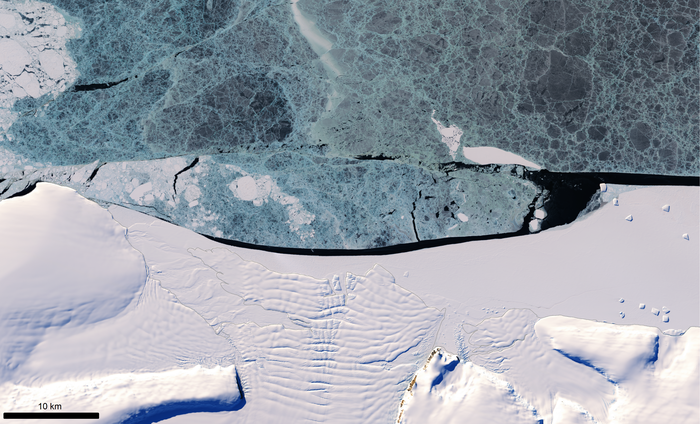Regardless of the fast melting of ice in several parts of Antarctica, scientists have discovered that the floating ice shelves that skirt the eastern Antarctic Peninsula have experienced sustained advance throughout the past two decades.
 Young (blue) and landfast (smooth white) sea ice offshore of New Bedford Inlet, eastern Antarctic Peninsula, as imaged by the Operational Land Imager instrument onboard the USGS/NASA Landsat 8 satellite on 5th March 2017. Image Credit: Frazer Christie
Young (blue) and landfast (smooth white) sea ice offshore of New Bedford Inlet, eastern Antarctic Peninsula, as imaged by the Operational Land Imager instrument onboard the USGS/NASA Landsat 8 satellite on 5th March 2017. Image Credit: Frazer Christie
Ice shelves—floating sections of ice connected to land-based ice sheets—act as the crucial reinforcement against the unrestrained release of inland ice to the ocean. During the late 20th century, the eastern Antarctic Peninsula witnessed the disastrous collapse of the Larsen A and B ice shelves in 1995 and 2002, respectively, due to high levels of warming.
These events triggered the hastening of ice toward the ocean, quickening the Antarctic Peninsula’s contribution to the increase in the sea level.
At present, it is still undecided how sea ice surrounding Antarctica will precisely evolve in reaction to climate change and consequently impact the increase in the sea level, with certain models predicting wholescale sea ice loss in the Southern Ocean, while others predict sea ice gain.
Currently, an international group of scientists from the Universities of Newcastle and Cambridge in the United Kingdom, and the University of Canterbury in New Zealand, have used a combination of historical satellite measurements, together with atmosphere and ocean records, to obtain the most thorough understanding yet of how ice settings are altering along the 1,400-km-long eastern Antarctic Peninsula.
They discovered that 85% of the ice shelf perimeter in this section of Antarctica has advanced since the early 2000s, contrary to the widespread retreat of the preceding 20 years. The advance is attributable to decade-scale deviations in atmospheric circulation, which has resulted in more sea ice being shifted to the coast by the wind.
The findings, published in the journal Nature Geoscience, propose that sea ice has a vital role to play in reinforcing ice shelves, quite like ice shelves themselves stabilizing and strengthening ice sheets.
We’ve found that sea-ice change can either safeguard from, or set in motion, the calving of icebergs from large Antarctic ice shelves. Regardless of how the sea ice around Antarctica changes in a warming climate, our observations highlight the often-overlooked importance of sea-ice variability to the health of the Antarctic Ice Sheet.
Dr Frazer Christie, Study Lead Author, SPRI, University of Cambridge
In 2019, Christie and his contemporaries were part of a Scott Polar Research Institute (SPRI)-directed voyage to explore ice conditions in the Weddell Sea offshore of the eastern Antarctic Peninsula, an extremely difficult part of the Southern Ocean to reach due to the thick and all-year presence of sea ice.
During the expedition, we noted that parts of the ice-shelf coastline were at their most advanced position since satellite records began in the early 1960s.
Professor Julian Dowdeswell, Expedition Chief Scientist and Study Co-Author, SPRI, University of Cambridge
After the voyage, the researchers used satellite images dating back 60 years, as well as advanced atmosphere and ocean models to study the temporal and spatial pattern of ice-shelf alteration.
Therefore, what made the ice shelves advance? In the absence of ocean and atmosphere warming over the past two decades, the dominant control was discovered to be a shift in regional wind patterns across the Weddell Sea, which served to thrust sea ice against the ice shelves.
From 1985 to 2002, in contrast, wind in the same region caused sea ice to shift away from the coast. By eliminating the reinforcement effect of the sea ice and exposing the ice shelves to destructive ocean waves, pressure on the ice shelves amplified, eventually causing the calving of icebergs.
In nearly all cases across the satellite era, calving from the eastern Antarctic Peninsula’s ice shelves only happened during or soon after eliminating sea ice in some form.
However, it may be possible that this era of ice advance could be concluding. Since 2020, there has been a prominent increase in the number of icebergs tearing away from the eastern Antarctic Peninsula.
It’s entirely possible we could be seeing a transition back to atmospheric patterns similar to those observed during the 1990s that encouraged sea-ice loss and, ultimately, more ice-shelf calving.
Dr Wolfgang Rack, Study Co-Author, University of Canterbury
The study was feasible owing to the free, open-access availability of the historical satellite record by space agencies and partners, including NASA and the joint European Commission—European Space Agency Copernicus Program.
The study was supported partly by Marine Archaeology Consultants Switzerland, the Flotilla Foundation, and the Prince Albert II of Monaco Foundation.
Journal Reference:
Christie, F. W. D., et al. (2022) Antarctic ice-shelf advance driven by anomalous atmospheric and sea-ice circulation. Nature Geoscience. doi.org/10.1038/s41561-022-00938-x.